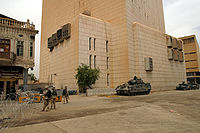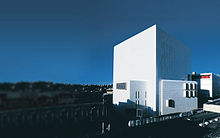- Central Bank of Iraq
-
Central Bank of Iraq
البنك المركزي العراقي
The Central Bank of Iraq, guarded by U.S. troops in June 2003. Headquarters Baghdad, Iraq Established 1947 Chairman Sinan Al-Shabibi Central bank of Iraq Currency Iraqi Dinar Website Official website The Central Bank of Iraq (Arabic: البنك المركزي العراقي) is the central bank of Iraq.
Contents
History
The Central Bank of Iraq was established as Iraq's central bank by Central Bank of Iraq Law 2004 with authorised capital of 100 billion dinars.[1] The current Governor of the Central Bank of Iraq is Sinan Al Shabibi.
Architecture
The bank headquarters were designed by Danish architects Dissing+Weitling And completed in 1985. It is a cubical building constructed of reinforced concrete clad in marble. It has few exterior openings, and is instead organised around an inner courtyard which cuts through the heart of the structure and rises to a height of 40m. The courtyard is surrounded on all sides by offices separated by an interior glass curtain wall.[2]
In August 2010, architect Zaha Hadid was appointed to design new headquarters for the Central Bank in Baghdad. Baghdad-born Zaha Hadid, was approached by the Iraqi authorities earlier that year; initial talks about the project were held in Istanbul on August 14, 2010 in the presence of Central Bank Governor Sinan Al-Shabibi.
Objectives
As of at least March 28, 2011, the official web site of the CBI states "the primary objectives of the Central Bank of Iraq (CBI) are to ensure domestic price stability and to foster a stable competitive market-based financial system. The CBI shall also promote sustainable growth, employment and prosperity in Iraq.". The CBI web site further states that the functions of the CBI in addition to the primary objectives mentioned above include:
- To implement the monetary policy and the exchange rate policy for Iraq.
- To hold gold and manage the state reserves of gold.
- To issue and manage the Iraq currency.
- To establish, oversee, and promote a sound and efficient payment system.
- To issue licenses or permits to banks and to regulate and supervise banks as further specified by the Banking Law.
- To carry out any related ancillary tasks or transactions within the framework of Iraqi law.
The objectives of the Central Bank of the Iraq are as follows:- maintaining inflation stability
- implementing monetary policy (including exchange rate policies)
- managing the state's reserves
- issuing and managing the Iraqi dinar
- regulating private banks.
As of December 2009, the bank reported total assets valued at over 57 trillion dinars.[3] The bank’s head office is located in Baghdad with four branches in Basrah, Mosul, Sulaimaniyah and Erbil. However, currently the bank does not control the financial and administrative affairs of Erbil and Sulaimaniyah branches, as these branches are technically reporting to the headquarter in Baghdad and for all other issues they are reporting to Kurdistan Regional Government (KRG) and they are financed by KRG.
As of July 2010 steps and measures have taken place in order to integrate these branches with the headquarter in Baghdad.
Foreign exchange reserves have increased to nearly US$58 billion (as of september 2011) due to a rise in oil revenues, indicating the improved ability since 2003 to deal with the repayement of foreign debt, the currency stabilization, and the coverage of average monthly imports.
The largest bank robbery in history
In March 2003, on several occasions beginning on March 18, the day before the United States began bombing Baghdad, nearly US$1 billion was stolen from the Central Bank of Iraq. This is considered the largest bank heist in history.[4]
In March 2003, a hand-written note surfaced, signed by Saddam Hussein, ordering $920 million to be withdrawn and given to his son Qusay. Bank officials state that Qusay and another unidentified man oversaw the cash, boxes of $100 bills, being loaded into trucks during a five hour operation.[5] Qusay was later killed by the U.S. Military in a battle.[6]
See also
- Economy of Iraq
- Politics of Iraq
- Financial institutions operating in Iraq
- Iraqi dinar
References
- ^ http://www.cbi.iq/documents/CBILAW-EN_f.pdf
- ^ "Central Bank of Iraq". Archnet. http://archnet.org/library/sites/one-site.jsp?site_id=838. Retrieved 2010-06-13.
- ^ http://www.cbi.iq/index.php?pid=FinancialStatements
- ^ [1]
- ^ Papers show Saddam snatched $1bn from bank a day before invasion
- ^ The Washington Post. http://www.washingtonpost.com/ac2/wp-dyn/A31549-2003Jul22?language=printer.
External links
- The Central Bank of Iraq official Website (Arabic) (English)
- Related topics - Bloomberg/BusinessWeek
- Related topics - Iraq Business News
- The Great Bank Roddedbbery
- UK troops foil Iraq bank robbery
- Papers show Saddam snatched $1bn from bank a day before invasion
Central banks Global GlobalBank for International Settlements · Basel Committee on Banking Supervision · Financial Stability BoardBy continent AfricaBank of Central African States · Central Bank of West African States · Bank of Algeria · Central Bank of Angola · Bank of Botswana · Bank of the Republic of Burundi · Bank of Cape Verde · Central Bank of the Comoros · Central Bank of the Congo · Central Bank of Djibouti · Central Bank of Egypt · Bank of Eritrea · National Bank of Ethiopia · Central Bank of The Gambia · Bank of Ghana · Central Bank of the Republic of Guinea · Central Bank of Kenya · Central Bank of Lesotho · Central Bank of Liberia · Central Bank of Libya · Reserve Bank of Malawi · Bank of Mauritius · Bank Al-Maghrib · Bank of Namibia · Central Bank of Nigeria · Bank of Somaliland · South African Reserve Bank · Bank of South Sudan · Bank of Sudan · Central Bank of Swaziland · Bank of Tanzania · Central Bank of Tunisia · Bank of Uganda · Bank of Zambia · Reserve Bank of ZimbabweAmericasCentral Bank of Argentina · Central Bank of Aruba · Central Bank of The Bahamas · Central Bank of Barbados · Central Bank of Brazil · Bank of Canada · Central Bank of Chile · Bank of the Republic (Colombia) · Central Bank of Cuba · Central Bank of Curaçao and Sint Maarten · Eastern Caribbean Central Bank · Bank of the Republic of Haiti · Central Bank of Honduras · Bank of Jamaica · Bank of Mexico · Central Bank of Nicaragua · Central Reserve Bank of Peru · Central Bank of Suriname · Central Bank of Trinidad and Tobago · Federal Reserve System (United States) · Central Bank of VenezuelaAsiaDa Afghanistan Bank · Central Bank of Bahrain · Bangladesh Bank · Royal Monetary Authority of Bhutan · Brunei Currency and Monetary Board · National Bank of Cambodia · People's Bank of China · Hong Kong Monetary Authority · Reserve Bank of India · Bank Indonesia · Central Bank of the Islamic Republic of Iran · Central Bank of Iraq · Bank of Israel · Bank of Japan · Central Bank of Jordan · National Bank of Kazakhstan · National Bank of the Kyrgyz Republic · Bank of Korea · Central Bank of the Democratic People's Republic of Korea · Central Bank of Kuwait · Banque du Liban · Monetary Authority of Macao · Bank Negara Malaysia · Maldives Monetary Authority · Bank of Mongolia · Central Bank of Myanmar · Nepal Rastra Bank · Central Bank of Oman · State Bank of Pakistan · Palestine Monetary Authority · Bangko Sentral ng Pilipinas · Qatar Central Bank · Monetary Authority of Singapore · Central Bank of Sri Lanka · Central Bank of Syria · Central Bank of the Republic of China (Taiwan) · Bank of Thailand · Central Bank of the United Arab Emirates · Central Bank of Uzbekistan · State Bank of VietnamEuropeEuropean Central Bank (Eurosystem) · National Bank of the Republic of Abkhazia · Bank of Albania · Central Bank of Armenia · Central Bank of Azerbaijan · National Bank of the Republic of Belarus · Central Bank of Bosnia and Herzegovina · Bulgarian National Bank · Croatian National Bank · Czech National Bank · Danmarks Nationalbank · Bank of England · National Bank of Georgia · Hungarian National Bank · Central Bank of Iceland · Central Bank of Kosovo · National Bank of Latvia · Bank of Lithuania · National Bank of the Republic of Macedonia · National Bank of Moldova · Central Bank of Montenegro · Norges Bank · Central Bank of the Turkish Republic of Northern Cyprus · National Bank of Poland · National Bank of Romania · Central Bank of Russia · National Bank of Serbia · Sveriges Riksbank · Swiss National Bank · Central Bank of the Republic of Turkey · National Bank of UkraineOceaniaPolicies and implementation PoliciesImplementationBretton Woods system Lists Names in italics indicate non-sovereign (dependent) territories, former countries, or states with limited recognitionCategories:- Central banks
- Baghdad
- Economy of Iraq
- Bank robberies
- Banks of Iraq
Wikimedia Foundation. 2010.

